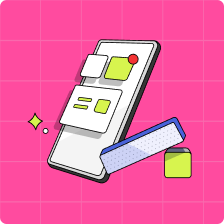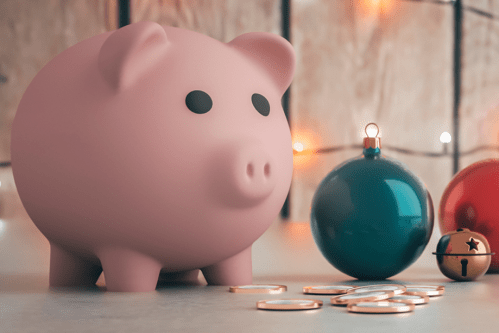Come January, many of us replace our holiday decorations with New Year’s resolutions. Often, these goals are centred around becoming healthier, learning a new skill or hobby, spending time with family, or improving finances. Whether your family wants to save for a dream vacation or stick to a budget, here are seven money New Year’s resolutions you can make in 2025.
Why make New Year’s resolutions?
New Year’s resolutions aren’t new. Humans have been making them for a long time! Over 4,000 years ago, the ancient Babylonians made promises to pay off debts or return things they had borrowed. The start of a new year is a great time to pause and take stock of what we achieved over the last year, and the ways we’d like to improve our lives going forward. Given rising inflation, those goals might only be modest ones. But even small steps forward can help you reach your goals.

What are financial goals?
Simply put, financial goals are short- and long-term measurable milestones that align with your money values and future.
Learn more: How to spend according to your values.
Financial goals can mean the difference between a wish and a plan. It’s not only adults who can benefit from setting financial goals. Kids and teens can also set a financial goal. Help your kids achieve success by encouraging them to make SMART goals.
That’s a goal that is:
- Specific
- Measurable
- Achievable
- Realistic
- Timely
For your teen, a SMART goal is the difference between simply saying they want to buy a new computer and deciding to save $100 a month to buy a laptop in July by getting a part-time job.
7 financial resolutions for families in 2025
Here are seven financial resolutions that will help families make 2025 a prosperous year.
1. Create a budget
If you don’t have a family budget, or you think it’s time for your kid or teen to create a budget for themselves, then start your New Year financial goal here. A balanced budget helps you plan where your money goes and if there’s enough to cover the essentials. It’s a skill that will serve your kids as they move into adulthood. To simplify the process, have your kids calculate their income (whether that’s an allowance or through a part-time job), allocate money for spending categories, such as lunch money or phone bill, and savings (ideally 20 per cent), and track their spending habits.
Learn more: How to create a budget for kids and teens

2. Pay down debt
If you’re carrying a balance on a credit card (or multiple credit cards), then paying down debt is a rewarding financial New Year’s resolution. Reducing debt can help reduce stress, improve your credit score, and save money on interest charges. If you’re not sure how much to put towards debt, use the 50/30/20 rule and put aside 20 per cent of your income towards debt repayment. For families with multiple debts or debts with high interest rates, you may wish to consider talking to a financial advisor about debt consolidation.
Learn more: How to pay off debt fast: A guide for parents and teens
3. Set a savings goal
Adults and kids alike can benefit from setting a savings goal. Is there a big purchase your kid wants to make this year? It could be a VR set or a new pair of sneakers. Help them create a savings plan, including a way to earn money (paying for chores around the house is one way that’s a win-win for everyone!), finding a place to put their savings, and a way to track their progress along the way. A good rule of thumb when it comes to savings is to put aside 10 to 20 per cent. Or perhaps there’s a family savings goal you’d like to commit to this year? It could be saving for a winter getaway next holiday season or upgrading your home entertainment system. Bonus: Mydoh makes saving easier for teens with our Savings Goal feature.
Tips: Kids and teens can use our free savings goal calculator to create a savings plan for the items on their wish list.
4. Check your financial health
The New Year is a great time to review your financial health. Check your credit score and order a free credit report through Equifax or TransUnion to make sure there are no discrepancies. This can also be a teachable moment to explain to your kids what a healthy credit score looks like and why it’s important down the road—they’ll need a good credit score for everything from finding an apartment to even landing a job. And speaking of financial health, trim down unnecessary expenses by unsubscribing to those subscriptions you really don’t need or have completely forgotten about. Get your kids to calculate how a $6.99 subscription here and a $15.99 subscription there can add up over the year. What else could you do with that money as a family?
Learn more: What is financial health and why is it important?

5. Introduce no spend days
Help make your family’s financial goals easier to stick to by introducing (and practicing) good financial habits like “no spend” days. Exactly like it sounds, agree on a day once a week, or even a couple of times a month, where no one taps their bank card. For greater success, pick a day where it’ll be easier for everyone to keep their cash in their pocket. That means no stopping for coffee on the way to work or home from school, take a packed lunch, and no shopping online. No spend days is one way to help kids and teens learn the difference between wants vs needs.
Learn more: How kids and teens can gamify their savings
6. Give to others
Why not resolve to give back to others in 2025? One way to help raise your kids to appreciate all they have is to have them give to others. Giving back could mean donating money or your time. Involve your kids and teens by asking them to research a cause dear to their hearts. If they’re not sure where to start, encourage them to research charities and organizations that help others in their community. As a family, you may decide to prepare home cooked food for people experiencing food insecurity, foster a future guide dog, or become involved in a social movement. Check out Charity Intelligence Canada or Canada Helps for more information on how you can give back.
Learn more: The best ways to teach kids about giving

7. Learn about financial literacy
Brushing up on financial literacy may sound like a pretty daunting resolution. But at its core, it’s teaching your kids and teens how to earn, save, and invest money. If you aren’t sure what the difference is between a TFSA and an RRSP, or if your teen has expressed an interest in playing the stock market, 2025 is your family’s year to learn. And it doesn’t have to be boring. Financial influencers make learning about money more interesting, or pick up a book that breaks down money basics.
Learn more: 8 reasons to teach financial literacy to kids and teens
How Mydoh can make sticking to your financial resolutions easier for your kids
Making a resolution is one thing, but meeting those goals means putting in the work. The Mydoh app and Smart Cash Card help kids and teens practice earning and spending their money securely. Mydoh also gives parents oversight, so you can watch their progress and encourage your kids to grow their savings—and their financial literacy—in 2025 and beyond!
Download Mydoh and get started today.
This article offers general information only and is not intended as legal, financial or other professional advice. A professional advisor should be consulted regarding your specific situation. While the information presented is believed to be factual and current, its accuracy is not guaranteed and it should not be regarded as a complete analysis of the subjects discussed. All expressions of opinion reflect the judgment of the author(s) as of the date of publication and are subject to change. No endorsement of any third parties or their advice, opinions, information, products or services is expressly given or implied by Royal Bank of Canada or its affiliates.


















